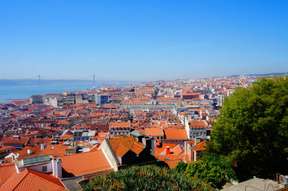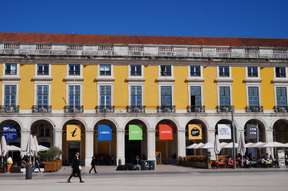
Cheap flights to Lisbon (LIS)
Traveloka helps you find cheap and promo flights to Lisbon (LIS)
Routes
Airline
Schedule
Price from
Interesting Activities in Lisbon






Flights to Lisbon, Portugal
Lisbon is the capital and the largest city of Portugal, with an estimated population of 505,526 within its administrative limits in an area of 100.05 km2. Its urban area extends beyond the city's administrative limits with a population of around 2.8 million people, being the 11th-most populous urban area in the European Union. About 3 million people live in the Lisbon Metropolitan Area, including the Portuguese Riviera, (which represents approximately 27% of the country's population). It is mainland Europe's westernmost capital city and the only one along the Atlantic coast. Lisbon lies in the western Iberian Peninsula on the Atlantic Ocean and the River Tagus. The westernmost areas of its metro area form the westernmost point of Continental Europe, which is known as Cabo da Roca, located in the Sintra Mountains. Lisbon is recognised as an alpha-level global city by the Globalization and World Cities (GaWC) Study Group because of its importance in finance, commerce, media, entertainment, arts, international trade, education and tourism. Lisbon is the only Portuguese city besides Porto to be recognised as a global city. It is one of the major economic centres on the continent, with a growing financial sector and one of the largest container ports on Europe's Atlantic coast.
Airports in Lisbon
1. Lisbon Airport
Humberto Delgado Airport also is known simply as Lisbon Airport, is an international airport located 7 km (4.3 mi) from the city centre of Lisbon, the capital of Portugal. The airport is the main international gateway to Portugal. It is the 18th-largest airport in Europe in terms of passenger volume, having served 29,006,042 passengers in 2018, an increase over the previous year of 8.8%. As of 2017, the airport handled 115.7 thousand tonnes of cargo. It is an important European hub to Brazil, the largest European Star Alliance hub to South America and also a European hub to Africa. The airport is the main hub of Portugal's flag carrier TAP Air Portugal including its subsidiary TAP Express also to being a hub for low-cost airlines Ryanair and EasyJet. It is a focus city for Azores Airlines, euroAtlantic Airways, Hi-Fly, Orbest, Vueling and White Airways. The airport is run by ANA Aeroportos de Portugal, which was concessioned to the French group Vinci Airports in February 2013. In January 2019, Portugal's government unveiled a 1.1-billion-euro ($1.26 billion) plan to expand Lisbon's current airport and build a second one in Montijo. It aims to handle around 50 million passengers a year from 2022.
How to Get Cheap Flights to Lisbon?
Traveloka is a travel search engine that makes it easy for travellers to find the cheapest flights to Lisbon. All you need to do is key in the information in the search box, and the application will recommend the best trip according to your budget. It compares flight prices across some trusted airlines to help you to get the best possible deal. Use Traveloka’s price alert feature to be notified of flights in your desired price range to get the best flight price to Lisbon.
When is the Best Time to Fly to Lisbon?
The best time to visit Lisbon is either from March to May or September to October, because the weather is still warm, hotel rates are cheaper, and there are fewer crowds than in summer. In those seasons, you might also be able to squeeze in a few beach days. The summer sees hot temperatures and crowded shores.
What are the Top 3 Things to Do in Lisbon?
1. Belém Tower - Belém Tower, the ""Tower of St Vincent"", is a fortified tower located in the civil parish of Santa Maria de Belém in the municipality of Lisbon, Portugal. It is a UNESCO World Heritage Site (along with the nearby Jerónimos Monastery) because of the significant role it played in the Portuguese maritime discoveries of the era of the Age of Discoveries. The tower was commissioned by King John II to be part of a defence system at the mouth of the Tagus river and a ceremonial gateway to Lisbon. The tower was built in the early 16th century and is a prominent example of the Portuguese Manueline style, but it also incorporates hints of other architectural styles. The structure was built from Lioz limestone and is composed of a bastion and a 30-metre (98.4 ft), four-storey tower. It has incorrectly been stated that the tower was built in the middle of the Tagus and now sits near the shore because the river was redirected after the 1755 Lisbon earthquake. The tower was built on a small island in the Tagus River near the Lisbon shore.
2. Jerónimos Monastery - The Jerónimos Monastery or Hieronymites Monastery is a former monastery of the Order of Saint Jerome near the Tagus river in the parish of Belém, in the Lisbon Municipality, Portugal; it was secularised on 28 December 1833 by state decree and its ownership transferred to the charitable institution, Real Casa Pia de Lisboa. The monastery is one of the most prominent examples of the Portuguese Late Gothic Manueline style of architecture in Lisbon. It was classified a UNESCO World Heritage Site, along with the nearby Tower of Belém, in 1983. The Jerónimos Monastery replaced the church formerly existing in the same place, which was dedicated to Santa Maria de Belém and where the monks of the military-religious Order of Christ provided assistance to seafarers in transit. The harbour of Praia do Restelo an advantageous spot for mariners, with a safe anchorage and protection from the winds, sought after by ships entering the mouth of the Tagus. The existing structure was inaugurated on the orders of Manuel I (1469–1521) at the courts of Montemor o Velho in 1495, as a final resting place for members of the House of Aviz, in his belief that an Iberian dynastic kingdom would rule after his death. In 1496, King Manuel petitioned the Holy See for permission to construct a monastery at the site. The Hermitage of Restelo (Ermida do Restelo), as the church was known, was already in disrepair when Vasco da Gama and his men spent the night in prayer there before departing on their expedition to the Orient in 1497.
3. São Jorge Castle - Sao Jorge Castle is a Moorish castle occupying a commanding hilltop overlooking the historic centre of the Portuguese city of Lisbon and Tagus River. The strongly fortified citadel dates from the medieval period of Portuguese history and is one of the main tourist sites of Lisbon. Although the first fortifications on this hilltop date from the 2nd century BC, archaeological excavations have identified a human presence in the Tagus valley as far back as the 6th century BC. The first fortification was, presumably, erected in 48 BC, when Lisbon was classified as a Roman municipality. The hill was first used by indigenous Celtic tribes, then by Phoenicians, Greeks, and Carthaginians as a defensible outpost that was later expropriated by Roman, Suebic, Visigothic, and Moorish peoples. During the 10th century, the fortifications were rebuilt by Muslim Berber forces; these included the walls or Cerca Moura (Moorish Encirclement.
Lisbon is the capital and the largest city of Portugal, with an estimated population of 505,526 within its administrative limits in an area of 100.05 km2. Its urban area extends beyond the city's administrative limits with a population of around 2.8 million people, being the 11th-most populous urban area in the European Union. About 3 million people live in the Lisbon Metropolitan Area, including the Portuguese Riviera, (which represents approximately 27% of the country's population). It is mainland Europe's westernmost capital city and the only one along the Atlantic coast. Lisbon lies in the western Iberian Peninsula on the Atlantic Ocean and the River Tagus. The westernmost areas of its metro area form the westernmost point of Continental Europe, which is known as Cabo da Roca, located in the Sintra Mountains. Lisbon is recognised as an alpha-level global city by the Globalization and World Cities (GaWC) Study Group because of its importance in finance, commerce, media, entertainment, arts, international trade, education and tourism. Lisbon is the only Portuguese city besides Porto to be recognised as a global city. It is one of the major economic centres on the continent, with a growing financial sector and one of the largest container ports on Europe's Atlantic coast.
Airports in Lisbon
1. Lisbon Airport
Humberto Delgado Airport also is known simply as Lisbon Airport, is an international airport located 7 km (4.3 mi) from the city centre of Lisbon, the capital of Portugal. The airport is the main international gateway to Portugal. It is the 18th-largest airport in Europe in terms of passenger volume, having served 29,006,042 passengers in 2018, an increase over the previous year of 8.8%. As of 2017, the airport handled 115.7 thousand tonnes of cargo. It is an important European hub to Brazil, the largest European Star Alliance hub to South America and also a European hub to Africa. The airport is the main hub of Portugal's flag carrier TAP Air Portugal including its subsidiary TAP Express also to being a hub for low-cost airlines Ryanair and EasyJet. It is a focus city for Azores Airlines, euroAtlantic Airways, Hi-Fly, Orbest, Vueling and White Airways. The airport is run by ANA Aeroportos de Portugal, which was concessioned to the French group Vinci Airports in February 2013. In January 2019, Portugal's government unveiled a 1.1-billion-euro ($1.26 billion) plan to expand Lisbon's current airport and build a second one in Montijo. It aims to handle around 50 million passengers a year from 2022.
How to Get Cheap Flights to Lisbon?
Traveloka is a travel search engine that makes it easy for travellers to find the cheapest flights to Lisbon. All you need to do is key in the information in the search box, and the application will recommend the best trip according to your budget. It compares flight prices across some trusted airlines to help you to get the best possible deal. Use Traveloka’s price alert feature to be notified of flights in your desired price range to get the best flight price to Lisbon.
When is the Best Time to Fly to Lisbon?
The best time to visit Lisbon is either from March to May or September to October, because the weather is still warm, hotel rates are cheaper, and there are fewer crowds than in summer. In those seasons, you might also be able to squeeze in a few beach days. The summer sees hot temperatures and crowded shores.
What are the Top 3 Things to Do in Lisbon?
1. Belém Tower - Belém Tower, the ""Tower of St Vincent"", is a fortified tower located in the civil parish of Santa Maria de Belém in the municipality of Lisbon, Portugal. It is a UNESCO World Heritage Site (along with the nearby Jerónimos Monastery) because of the significant role it played in the Portuguese maritime discoveries of the era of the Age of Discoveries. The tower was commissioned by King John II to be part of a defence system at the mouth of the Tagus river and a ceremonial gateway to Lisbon. The tower was built in the early 16th century and is a prominent example of the Portuguese Manueline style, but it also incorporates hints of other architectural styles. The structure was built from Lioz limestone and is composed of a bastion and a 30-metre (98.4 ft), four-storey tower. It has incorrectly been stated that the tower was built in the middle of the Tagus and now sits near the shore because the river was redirected after the 1755 Lisbon earthquake. The tower was built on a small island in the Tagus River near the Lisbon shore.
2. Jerónimos Monastery - The Jerónimos Monastery or Hieronymites Monastery is a former monastery of the Order of Saint Jerome near the Tagus river in the parish of Belém, in the Lisbon Municipality, Portugal; it was secularised on 28 December 1833 by state decree and its ownership transferred to the charitable institution, Real Casa Pia de Lisboa. The monastery is one of the most prominent examples of the Portuguese Late Gothic Manueline style of architecture in Lisbon. It was classified a UNESCO World Heritage Site, along with the nearby Tower of Belém, in 1983. The Jerónimos Monastery replaced the church formerly existing in the same place, which was dedicated to Santa Maria de Belém and where the monks of the military-religious Order of Christ provided assistance to seafarers in transit. The harbour of Praia do Restelo an advantageous spot for mariners, with a safe anchorage and protection from the winds, sought after by ships entering the mouth of the Tagus. The existing structure was inaugurated on the orders of Manuel I (1469–1521) at the courts of Montemor o Velho in 1495, as a final resting place for members of the House of Aviz, in his belief that an Iberian dynastic kingdom would rule after his death. In 1496, King Manuel petitioned the Holy See for permission to construct a monastery at the site. The Hermitage of Restelo (Ermida do Restelo), as the church was known, was already in disrepair when Vasco da Gama and his men spent the night in prayer there before departing on their expedition to the Orient in 1497.
3. São Jorge Castle - Sao Jorge Castle is a Moorish castle occupying a commanding hilltop overlooking the historic centre of the Portuguese city of Lisbon and Tagus River. The strongly fortified citadel dates from the medieval period of Portuguese history and is one of the main tourist sites of Lisbon. Although the first fortifications on this hilltop date from the 2nd century BC, archaeological excavations have identified a human presence in the Tagus valley as far back as the 6th century BC. The first fortification was, presumably, erected in 48 BC, when Lisbon was classified as a Roman municipality. The hill was first used by indigenous Celtic tribes, then by Phoenicians, Greeks, and Carthaginians as a defensible outpost that was later expropriated by Roman, Suebic, Visigothic, and Moorish peoples. During the 10th century, the fortifications were rebuilt by Muslim Berber forces; these included the walls or Cerca Moura (Moorish Encirclement.
Airline Partners
Top Packages Destination
More Xperience in Lisbon
Top Flight Routes




















 Facebook
Facebook Instagram
Instagram TikTok
TikTok Youtube
Youtube Twitter
Twitter Telegram
Telegram
